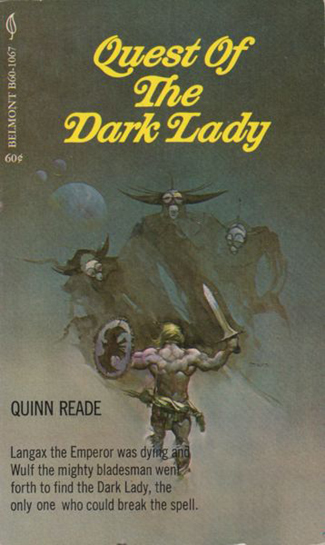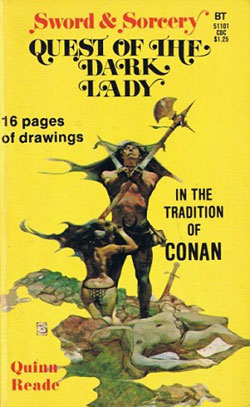 Sword & sorcery is the man’s fiction side of fantasy. It is no surprise to see writers known for westerns or men’s adventure wade into the sub-genre in the great days of paperback publishing. There were cases of western fiction writers producing historical novels about barbarians (Philip Ketchum, T. V. Olsen, Gordon D. Shirreffs).
Sword & sorcery is the man’s fiction side of fantasy. It is no surprise to see writers known for westerns or men’s adventure wade into the sub-genre in the great days of paperback publishing. There were cases of western fiction writers producing historical novels about barbarians (Philip Ketchum, T. V. Olsen, Gordon D. Shirreffs).
One of the writers better known in other genres was Ben Haas (1926-1977). Haas’ first novel was for Lancer Books (!) Two Surgeons in 1962. He produced spy, Civil War, and a couple more mainstream novels. Then in 1969, he went all genre. The first of his “Fargo” books came out in 1969. Neal Fargo is a soldier of fortune in the years leading up to WW1. He is one of the most Conanesque characters I have ever seen outside of sword & sorcery. The books are historically accurate including guns used. There is lots of wonderful gun-porn in the Fargo books.
In 1969, Haas had his first sword & sorcery novel, Sword of Morning Star. David Hartwell was an editor at New American Library and was responsible for some sword & sorcery novels that were a cut above the general level of the time. He got Lin Carter to produce his best novel, Lost World of Time.
Haas had two novels with the same setting as “Richard Meade”: Sword of Morning Star (Signet, 1969) and Exile’s Quest (Signet, 1970). They are post-apocalyptic, after what appears to be nuclear war, and set in Germany from the names. Helmut is the hero looking for vengeance against a usurper who killed his father, the king and chopped off his hand. Exile’s Quest is set before the events of Morningstar features Baron Gallt sent on a suicide mission. Neither Helmut and Gallt are barbarians. Helmut fights barbarians in fact.
Quest of the Dark Lady was from Belmont Books in 1969 under the name “Quinn Reade.” It has a Jeff Jones cover, one of his better paintings from this period. This also has a post-apocalyptic setting. Wulf, a captain of a company of mounted bladesmen is in the dungeon charged with treason. His company was wiped out on the border of the Iron Lands. King Langax is dying from a spell, so Wulf is sent with counseler Dr. Delius and the highway woman, Reen to the East to end this spell. There is plenty of action on the quest to reach the Dark Lady.
Wulf has black hair and acts in a general Conan like way in this novel. More than Helmut and Gallt. Haas’ sword & sorcery has its own unique quality to it with the post-apocalyptic settings and the Teutonic names of the heroes. It is what my old friend Steve Tompkins and I used to call “Desmond Killstar.” Karl Edward Wagner might have had Haas’ novels in mind when he had his fictional writer, Damon Harrington writing novels about Desmond Killstar. I also wonder if Norman Spinrad had Haas’ novels in mind with his so-called parody novel, The Iron Dream. I need to take an un-ironic look at The Iron Dream. L. Sprague de Camp rated Sword of Morningstar as “pretty good.”
Ben Haas’ writing style is men’s fiction paperback in execution. Pulp derived though more adult in male-female situations. By all means, pick these up if you run across them in a used bookstore. Quest of the Dark Lady had another printing from Belmont Tower in 1976 reusing a Jeff Jones cover originally used for Lin Carter’s The Quest of Kadji. Haas would have written this novel for the men’s paperback editor, Peter McCurtin, who wrote some wild stuff himself.
“It has a Jeff Jones cover, one of his better paintings from this period.”
Agreed.